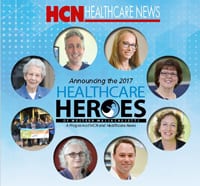New Frontiers – Access to Clinical Trials Expanding in Western Mass
Avital Carlis says the doctors at Cooley Dickinson Hospital and Mass General Hospital have a joke they’ve used since the institutions merged in 2013.
“We joke that doctors frequently have hallway conversations, and we have the same thing, except the hallway is Route 90,” said Carlis, administrative director of the Mass General Cancer Center at Cooley Dickinson Hospital, which opened last fall. “And these relationships are where our connections to clinical trials emanate from.”
Indeed, oncology patients being treated at CDH now have a referral pipeline to enroll in the kind of clinical trials Mass General has been involved in for decades, she went on.
“I’m very excited that the Mass General Cancer Center will be integrated with the clinical trials available there,” she told HCN. “Our doctors constantly review cases, and if a patient has unique circumstances, they’ll reach out to their colleagues in Boston, and the doctors in Boston might say, ‘great trial available,’ or ‘perfect match,’ or ‘we really should get them in this,’ and we can get our patients involved in these clinical trials. There is a huge spectrum of trials open to us.”
The affiliation opens doors that patients at Baystate Medical Center in Springfield have long been able to access. A robust clinical-trials program there — patients are currently participating in about 60 different ones — is available for both adult and pediatric patients, depending on need and what’s available.
“Basically, we’re an academic medical center, so we’ve had a clinical-trials program here for quite a few years,” said Dr. John McCann, a medical oncologist at Baystate who works with adult cancer patients. “The newer clinical trials are focusing on the specific molecular features of patients’ individual cancers and bringing new treatments to the cancer center that we can use. Because we have an entire team of clinical researchers working with us, we’re able to do sophisticated clinical trials right here at home, so patients don’t have to travel to go to another academic medical center.”
He cited, as one example, a new trial that seeks to evaluate three immunotherapy drugs given simultaneously for patients with advanced melanoma.
“It’s very important that patients get really leading-edge clinical trials right here in Western Mass.,” he added, noting that Baystate’s clinical-trials division accesses national trials through organizations like the National Cancer Institute, the National Institutes of Health, and pharmaceutical companies.
Mercy Medical Center, like Cooley Dickinson, will soon be able to access trials through a new affiliation — in its case, with Smilow Cancer Hospital at Yale-New Haven Hospital, with which it has signed a letter of intent to pursue a relationship that will enhance cancer care at Mercy.
The partnership with Smilow will create new opportunities for patients in Western Mass. to enroll in clinical trials for a wide variety of cancers, said Dr. Philip Glynn, director of medical oncology at the recently expanded Sr. Caritas Cancer Center on the Mercy campus.
“Trials are really important because people get a chance to see if a new treatment can help them — or help a population of patients in general,” he explained. “It’s almost like having a built-in insurance policy; you know you’re getting the most recent treatment. It’s been reviewed by experts, and you’re being very carefully monitored by your doctor. The added benefit is that people feel gratified to be able to help advance new types of research.”
The downside, of course, is that previously unknown side effects may arise, and the treatment simply may not work.
“Ideally, you’re being carefully monitored so you can be taken off if it becomes clear it’s not working and there are other alternatives,” Glynn said. “Another downside is that some of these trials have placebos, and people don’t necessarily get the treatment they hoped they’d get.”
With more hospitals joining Baystate locally in providing access to clinical trials available nationwide, it’s a decision patients will increasingly have to answer.
Put to the TestvSimply put, Glynn said, a clinical trial is a research study, and patients participate to answer a question or help improve or advance treatment of a disease.
“In my field, oncology, patients volunteer for clinical trials that test new treatments, to see how they compare with current treatment standards. Sometimes they test lifestyle changes to see if it lowers the chances of getting cancer. Sometimes they test new ways of finding out if people have cancer — diagnostic studies.”
Typically, trials are divided into three types, he explained. Phase 1 trials, which are most commonly conducted in a university setting, aim to answer questions about safety in terms of timing, dosage, and side effects. Phase 2 — the type of trial most-often available locally — delves further into safety but focuses more on effectiveness. Phase 3 trials compare the new treatment with the current standard, by placing patients randomly (and blindly) into one group or the other.
Not everyone who wants to take part in a trial may do so, Glynn noted, due to any number of contraindication factors. “There are times people may want to be in a study but are excluded based on pre-existing conditions.”
But plenty are able to enroll, McCann said, noting that some patients inquire about what opportunities are available to try new therapies, while others are steered toward trials by their doctor.
“If a patient is eligible for a trial, we go through the process in detail and talk about risks and potential benefits,” he explained. “Then the patient makes the decision whether or not they wish to participate in the trial.”
Which means they’re well-informed of all known risk factors, he went on. “Every clinical trial has risks associated with it. We’re committed to the highest standards in terms of minimizing risk and also explaining very clearly to patients what risks are associated with the treatment.”
In many cases, however, patients have reached a point of desperation, said Dr. Matthew Richardson, a pediatric oncologist with Baystate Children’s Hospital.
“For some conditions, where the prognosis with traditional medicine is poor or at least not optimistic, I think people are motivated to try new things,” he told HCN. “They also realize it may help other children in the future. I think that appeals to many patients — that ability to help other families and other people’s children in the future.”
The goal of any clinical trial, particularly in phase 3, is to compare new treatments or tests to standard tests, and that can’t be done with just one or two patients; researchers need hundreds — and because certain pediatric cancers are so uncommon, no single center will be able to provide that, he explained. That’s why Baystate is part of the Children’s Oncology Group (COG), which gives patients there access to the same trials offered at other children’s hospitals across the country.
Richardson is one of several doctors — as well as pharmacists and people not directly involved in the medical community — who sit on an institutional review board (IRB) that evaluates clinical-trial opportunities to make sure they’re appropriate for Baystate, that the science is sound, and that potential risks are not worse than the standard treatment — or, if the risks are high, that the potential benefit outweights the risk.
“We conduct a very thoughtful analysis, through very extensive discussions, before a clinical trial even begins at the hospital,” he said. “And if a member of the IRB is involved in the clinical research, they’re not allowed to weigh in on approval.”
Expanding the Pipeline
Patients intrigued by the opportunity to participate in this type of research have to be gratified by the new opportunities cropping up in Western Mass., from Mercy to CDH to, yes, a widening pipeline at Baystate.
We’re referring to UMMS-Baystate Health, a campus of UMass Medical School expected to open in Springfield in the fall of 2017. The project — a collaboration between the medical school, UMass Amherst, and Baystate Health — is intended to meet three goals: increasing access to students in Massachusetts seeking an affordable medical education, responding to the healthcare needs of the Commonwealth by increasing the number of Massachusetts physicians trained in urban and rural primary care, and applying academic research to improve population health, reduce health disparities, and make healthcare better integrated, more efficient, and more effective.
“It’s really a game changer for the region,” said Dr. John Schreiber, chief physician executive for Baystate Health, and one of the reasons is access to new avenues for clinical trials through UMass Medical School. “We’ll be able to offer patients in the Pioneer Valley much more than we have previously.”
And one of the goals for physicians coming out of the program is that they understand how to be part of a clinical trial and how to connect patients with experimental therapies. “We want to be able to access that across the Baystate system, not just in Springfield. The outlook is bright.”
With all the optimism over clinical trials, CDH’s Carlis stressed that eligibility criteria can be narrow.
“What’s nice about our relationship with our colleagues in Boston is, many of these physicians are world-renowned experts in their field; they know these criteria backward and forward. So, if we think a patient might be eligible, there’s no assumption made until they speak with the people in Boston for a full criteria check.”
That said, the big picture is important. “Through clinical trials, we’re trying to identify where care is going in the future, what are the best combinations of drugs. It opens opportunities for patients they would not otherwise have access to.”
Glynn agreed. “Clinical trials are designed by experts to answer specific questions about therapies,” he explained. “It’s very important, especially today, because there are so many new therapies available for patients in oncology. We want to be able to offer patients as broad a spectrum of potential treatment options as we can.”
After all, Richardson concluded, these are matters of life and death.
“We’ve gone from acute lymphoblastic leukemia in children being a uniformly fatal disease to having some types of leukemia with a 90{06cf2b9696b159f874511d23dbc893eb1ac83014175ed30550cfff22781411e5} cure rate,” he said. “And that’s only been through cooperative clinical trials.”





Comments are closed.